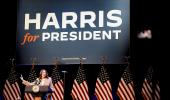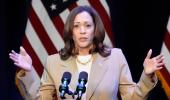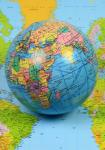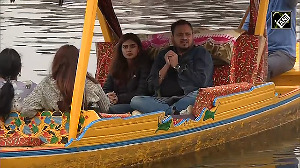Thousands of workers of every description -- from journalists to steel workers, from painters to New York cops, from auto to engineering workers -- marched for four hours down 5th Avenue one of Manhattan's most iconic thoroughfares, reports Jyoti Punwani.

PSC CUNY is a trade union that represents faculty and professional staff of the City University of New York campuses. All photographs: Jyoti Punwani
Music, dance, floats and school bands: The 142nd annual New York Labor Day Parade was a spectacle of the kind rarely associated with workers in India.
Thousands of workers of every description -- from journalists to steel workers, from painters to the New York Police Department (traffic division), from auto to engineering workers -- marched for four hours down one of New York's most iconic thoroughfares.
Parts of Fifth Avenue, home to the most expensive hotels and flagship stores of luxury brands -- and also Trump Tower -- were barricaded for traffic on a Saturday as New York's workers marched from 10 am to 2 pm.

It is difficult to imagine Mumbai's authorities allowing unions so much space in the city. But then, as the placards said: 'New York is a Union Town'. And Saturday was a day for unions to celebrate their strength.
Many of the them had brought their members in decorated trucks; some had hired open air double-decker tourist buses.
The engineering workers had brought their cranes and bulldozers; the American flag hung from these giant machines.

The US flag was carried by a number of unions; a strange sight in a workers' parade. There was also the placard: 'Pro-union, pro-America'.
Overall, this parade was absolutely different from any workers' march seen in India.

Just before its final destination, a small podium had been set up on the pavement, where a band played workers' songs, which had many of the rallyists dancing.
As different contingents reached that point, the compere called out their names, and those of their leader, welcoming them. But no speeches were made.

The varied groups of workers dispersed after reaching the destination.

The theme of this year's parade was 'All Workers, Many Voices, One Fight'.
The 200-odd unions indeed represented many voices, ranging from the biggest, such as the United Steelworkers and the United Automobile, Aerospace and Agricultural Implement Workers of America (UAW), to doctors' unions and the Accountants, Statisticians and Aquaries union, as well as the union of Rent Regulation Services employees.
A surprise inclusion was the NYPD traffic police.

In India, policemen are not allowed to unionise. In the US, said the NYPD traffic union spokesperson, they were not allowed to strike, but they could unionise and negotiate.
Interestingly, the NYPD traffic band, which played at this parade, had also played at the India Day parade held in the city on August 18, the spokesperson informed me.

Among the smallest contingents was that of post-graduate scholars from New York's famous private universities: Columbia, Cornell and New York University. Not surprisingly, it included two Indians.
Post-doctorate researchers, whose work is invaluable to their universities, have been struggling over the last few years to unionise, and universities, including the most prestigious of them, have fought this with all their might.

Columbia University's post-docs have managed to sign a contract with the university, the post-docs at the parade told me.
Their demands included better pay, better child care facilities, dental insurance (normally not covered by health insurance in the USA), and better arbitration mechanisms.

Funnily enough, this union was affiliated to the UAW, as was the union of university teachers working in private universities.
Given the long and successful history of the UAW, many sections of workers have chosen to affiliate with it.
However, those employed by the government-funded City University of New York marched under a separate banner.

Then there were the journalists affiliated to the Newsguild (this reporter was given a Newsguild sticker too). Representing all New York's newspapers as well as magazines, the main problem they faced, they said, was layoffs.
They had found union membership dwindling simply because they there were less of them around with jobs. They were now trying to rope in digital newspersons, they said.

Did they face censorship issues?
"Not really," said one who had come with her toddler, "except recently on the Gaza issue."
"The Gaza issue" was flaunted by the UAW; their placards called for a ceasefire.

While the UAW was the only union which openly declared their stand on Palestine, some of the other unions had placards supporting Kamala Harris for President.
"Democrats have always been union-friendly," said one worker.
In fact, Biden is seen as among the most pro-union presidents in recent history, and Kamala Harris has been the chair of the White House Task Force on Worker Organizing and Empowerment.

In September last year, Biden had dropped in on a picketing line of auto workers affiliated to the UAW in Michigan, who were on the 11th day of their strike against America's three major auto companies: Ford, General Motors and Stellantis.
Biden wasn't just passing by; he went there on the invitation of the UAW President.

This kind of gesture would be unimaginable in India, where governments have always treated workers with disdain and hostility, specially if they are organised.
However, in the US, unions have been a constituency for the Democratic Party for many decades; their votes decide outcomes in certain states.

The Labor Day Parade in New York is more than 100 years old. The first such parade was held here on September 5, 1882 as an assertion of workers' rights.
The credit for conceiving it goes to the leaders of the two main unions that existed then: The Central Labor Union of New York, Brooklyn and Jersey City and the American Federation of Labor.

Even at that time, though it was announced as a display of the 'strength and esprit de corps of the trade and labour organisations', it was a celebration.
The 20,000 men who marched with banners proclaiming 'No Money Monopoly' and 'Labour Built This Republic and Labour Shall Rule I, ended the parade with music and dance in Madison Square park.

New York's parade inspired other cities in the USA to hold similar parades.
September 5 became a Labor Day Holiday through a bill passed first in New York city, and then a law in Oregon.
Today, the parade is held on the first or second Saturday of every September.
Unlike Mumbai, which was a union city, New York, the largest city of the capitalist Mecca that is America, remains a Union city.
Feature Presentation: Ashish Narsale/Rediff.com











 © 2025
© 2025